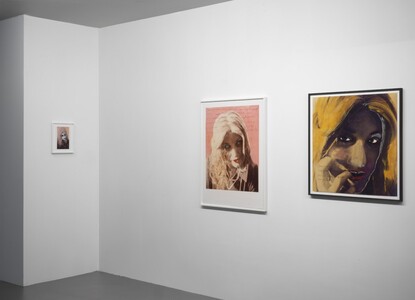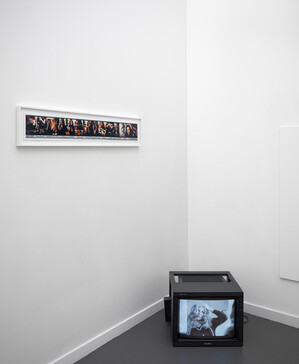Solo Exhibition Rozenstraat, Amsterdam, Netherlands
ROZENSTRAAT – a rose is a rose is a rose is delighted to present Staged Intimacy 1974-2019, a solo exhibition by Lynn Hershman Leeson (1941, United States) which includes some of her most impressive works.
In her career, that spans over six decades, Hershman Leeson has always been at the forefront of using the potential of new technological developments. In her highly innovative, personal and often-long term research-based projects she addresses topics ranging from exploring and performing identity to the relation between humans and digital technology. All themes that are incredibly topical in our current times. In the last few years, she has increasingly focused her research on biotechnical developments and their impact on our daily lives, for which she collaborated with a wide range of acclaimed scientists, technologists and other experts. Hershman Leeson’s visionary practice makes her a true pioneer. A pioneer who only recently earned wider recognition for her contributions to performance art, new media and film since the 1960s.
Central to Staged Intimacy is a shifting dynamic between the representation of identity, the private and public domain and the development of (digital) technologies. The exhibition brings together three key projects of Hershman Leeson that offer a representative introduction to the artist’s oeuvre: The Roberta Breitmore Series (1974-1978), The Electronic Diaries (1984 -2019) and a part of Shadow Stalker (2019). Together they highlight the relation between the intimate and the political, evolving from the artist’s personal life towards a more general, societal level.
The Roberta Breitmore Series, of which we show a series of photographs and the video Lynn Turning into Roberta, documents the existence of ‘another self’, the fictitious Roberta Breitmore, invented and brought to life by Hershman Leeson herself. After the first ‘public performance’ of Roberta, which consisted of arriving in San Francisco with a Greyhound bus and checking into the Dante Hotel, the artist’s alter ego slowly but surely began to emerge and became an increasingly concrete personality. The shy and somewhat neurotic Roberta had her own dress code, body language and handwriting but also attended weightwatchers sessions and dated several men. She even had her own driver’s license. In a way she became more real than the artist. “I needed to build her so that she would exist in history and be more relevant and credible than I was. And she was! She got credit cards, and I couldn’t.” It is not without reason that The Roberta Breitmore Series are regarded as a strong feminist work. As an avatar avant-la-lettre, Roberta appeals to the desire to escape from yourself and to freely explore and experiment life somewhere between reality and fantasy. Yet, Roberta is described as a woman plagued by complexes and phobias, and at some point, Roberta’s traumas became the haunting memories of Hershman Leeson. “They would surface with no warning, with no relief. She began to control me. I was never free of her.” In 1978 the artist released herself from Roberta, when she was exorcised at the grave of the renaissance femme fatale Lucrezia Borgia.
While The Roberta Breitmore Series is characterized by fiction, extraversion and a strong performative component focusing on the outside world and blurring the boundaries between art and life, The Electronic Diaries initially stays closer to the artist and can be considered as an introspective time-document or as a personal archive of Hershman Leeson, determined until a great extent by her own past and context. In six chapters, of which the final two now have their premiere in Europe, the artist shares traumatic experiences, struggles and reflections on her life, examining possibly unspoken memories against the background of world news of that time. Although originated from another need, the confessional and semi performative approach Hershman Leeson was taking in front of her camera, already in the 80s, is a remarkable foreshadowing of the contemporary habit of presenting oneself online to anonymous strangers in vlogs or on reality tv. Perhaps as a way to translate the versatility of the past, or in a therapeutic attempt to control or even conjure her traumas, several events and thoughts are discussed in multiple ways, almost as if she allows different characters to have their say. Sometimes Hershman Leeson takes a cool and aloof approach, other times she seems softer and more emotional. The Electronic Diaries can be understood both as a quest for and a conservation of ‘identity’. How and for whom do we construct ourselves? “I had no grounding for who I was. I was seeking in everything I did to find an identity. Something I could hold. Images of myself. Almost as evidence that I existed. Captured in order to survive.” Gradually, the diaries distance themselves from the autobiographical informed approach with which they start and move towards discussing the possibilities of biogenetic technologies, raising questions around the ethics of these technologies, and their impact on the human body and individuality. Topics such as genetic (trauma) inheritance and transmittance, gene editing and digital DNA preservation are brought to the fore and are further explained by scientists and geneticists. How is (digital) technology able to contain our histories and our lives? And how can it offer new ways to overcome personal and social trauma? These questions turn out to be central in The Electronic Diaries.
The symbiosis between digital- and cyber technology and humans also forms the starting point of the artist’s latest project Shadow Stalker, of which one part of the originally larger installation, is shown in the video room of ROZENSTRAAT. The attention in this work is shifted from the artist’s life and the positive aspects of technological developments towards the dangers of the digital evolution for contemporary consumers of the internet in general. Shadow Stalker deals with data mining, digital identity theft, secret surveillance and the controversial practice of predictive policing. The latter attempts to forecast crime with algorithmic techniques and supposedly has reduced crime. At the same time however, it demonstrably reinforces existing racial biases. Shadow Stalker thus investigates and reveals issues related to the influence of cyberspace on individuals and society in a broad sense, raising awareness of our vulnerability online.
Lynn Hershman Leeson lives and works in San Francisco and New York. Her most recent exhibitions include solo presentations at CA2M, Madrid (2019); KW Institute for Contemporary Art, Berlin; Haus der Elektronischen Künste, Basel (both in 2018) and ZKM Center for Art and Media, Karlsruhe in 2014. Her work has been included in group exhibitions at the de Young Museum, San Francisco (2020); The Shed, New York (2019); Walker Art Center, Minneapolis (2019); Institute of Contemporary Art Boston (2018); Whitney Museum of American Art (2017) and the Whitechapel Gallery, London (2016) as well as in international biennials including the Riga Biennial of Contemporary Art (2018) and the recently opened 2020 Gwangju Biennial. Hershman Leeson’s work is represented in museum collections such as SFMOMA; Los Angeles County Museum of Art; Walker Art Center and Tate Modern. Forthcoming is her solo-exhibition Lynn Hershman Leeson: Twisted at the New Museum in New York which opens in July 2021.
ROZENSTRAAT – a rose is a rose is a rose would like to thank Paul van Esch & Partners Art Advisory and Diego Diez for their support in realizing this exhibition.
More Pictures:







